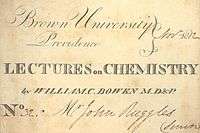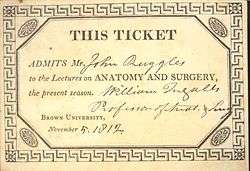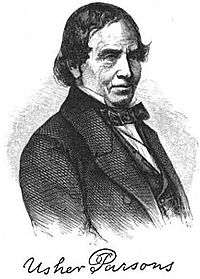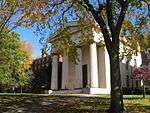Alpert Medical School
The Warren Alpert Medical School (formerly known as Brown Medical School, previously known as Brown University School of Medicine) is the medical school of Brown University, located in Providence, Rhode Island, United States. Established in 1811, the school was among the first in the nation to offer academic medical education. Today, Alpert Medical School is a component of Brown’s Division of Biology and Medicine, which also includes the Program in Biology. (A third component of the Division, the Program in Public Health, became the Brown University School of Public Health on July 1, 2013.) Together with the Medical School’s seven affiliated teaching hospitals, the Division attracts over $300 million in external research funding per year.[2]
 Richmond Street building | |
| Type | Private |
|---|---|
| Established | 1811, closed about 1827, re-opened 1972 |
| Dean | Jack A. Elias, M.D. |
Academic staff | 2,569[1] |
| Students | 466[1] |
| Location | Providence , Rhode Island , USA |
| Campus | Urban |
| Website | med.brown.edu |
 | |
The fourth most selective medical school in the United States,[3] Alpert Medical School earned rankings of twenty-first for primary care education and thirty-first for research in the 2017 U.S. News & World Report rankings.[4] Alpert was also ranked in the top 20 medical schools in the nation by Business Insider.[5] Graduates of Alpert Medical School are accepted into competitive residency programs and leading medical centers.[6]
History

Brown University first organized a medical program in 1811, following examples set by its New England neighbors, Harvard University and Dartmouth College. When President Wayland called for all Brown faculty to reside on campus, the physicians serving as voluntary clinical faculty refused to jeopardize their practices in order to comply. In 1827, President Wayland suspended the fledgling medical program. There were 87 graduates of Brown's first program in medicine. The medical school was restarted in 1972 as the Program in Medicine and the first M.D. degrees of the modern era were awarded to a graduating class of 58 students in 1975. The Program in Medicine was renamed Brown University School of Medicine in 1991, and renamed Brown Medical School in 2000.
On campus, the 168,800-square-foot (15,680 m2), $95-million Sidney Frank Hall for Life Sciences opened in October 2004. The facility houses more than 60 new laboratories, a functional Magnetic Resonance Imaging facility, and an electron microscopy suite and supports research in the departments of Neuroscience and Molecular Biology, Cell Biology and Biochemistry. Taken together, these two new facilities represent an increase of approximately 75 percent in Brown's laboratory capacity for life science research.[7] Medical School preclinical classes were formerly held in the adjacent Bio-Med Center, Multidisciplinary Laboratories, and Smith-Buonano Hall of the Pembroke Campus. However, since the completion of renovations at 222 Richmond Street, all preclinical coursework, as well as 3rd and 4th year shelf exams and OSCEs are located at the new building (see below).

In January 2007, self-made entrepreneur Warren Alpert donated $100 million to Brown Medical School, tying Sidney Frank for the largest single monetary contribution ever made to the University. In recognition of the gift, Brown Medical School was renamed to The Warren Alpert Medical School of Brown University. The funds contributed to the construction of a new medical education facility, medical student scholarships (through the Warren Alpert Scholars Program), support for biomedical research and faculty recruitment, and new endowed professorships.[8]
In August 2011, the University and Medical School completed the process of renovating a University-owned property at 222 Richmond Street in the Jewelry District of Providence. The Medical Education (Med-Ed) facility, which now houses pre-clinical classes, anatomy and histology labs, simulation facilities (Clinical Skills Unit), student study space and resources, and the majority of the medical school Administration.[9] Brown University also invested in several community enhancements in the area surrounding the medical school's new home, including a police substation shared by Providence and Brown police, a new public plaza called Ship Street Square, and new trees, sidewalks, and street paving. The relocation of Brown's medical school marks the initial stages in Providence's efforts to revamp the Jewelry District as a hub of medical research and biotech industry.[10] Governor Lincoln Chafee hailed the school's opening as "a catalytic moment in the history of Rhode Island."[11]
Admissions and rankings

Brown Alpert Medical School is one of seven Ivy League medical schools and is currently ranked 21st for primary care education and 31st for research by the 2017 U.S. News and World Report rankings.[13] Alpert was ranked in the top 25 medical schools in the U.S. by both Business Insider and by a medical education rankings study conducted by Matthew J. Goldstein and colleagues at Harvard Medical School.[5][14] One of the most selective medical schools in the United States based on an acceptance rate of 2.7%,[15] Alpert enrolls approximately 144 students per class. In 2016, Alpert received 6,374 completed applications and interviewed 370 applicants for 90 spots open through the American Medical College Application Service (AMCAS). Other routes of entry include the eight-year Program in Liberal Medical Education (PLME) and a small number of linkage programs. The 2016 matriculating class had an average GPA of 3.8 and MCAT score of 514.[16]
Students interested in studying at Alpert Medical School may apply through a variety of admissions routes designed to enroll a diverse and highly qualified student body. Approximately 30% of the entering class is composed of students from the 8-year Program in Liberal Medical Education (PLME) and special linkage agreement programs. In 2004, the school began to accept premedical students from other colleges and universities via AMCAS through a standard route of admissions. According to the school's website, for the Fall 2016 entering class, Alpert Medical School received 6,374 secondary applications and interviewed 370 candidates through the AMCAS route."[17]
Curriculum

A restructuring of the pre-clinical curriculum was implemented in 2006, with the goal of achieving an integrated, contemporary and flexible medical curriculum. Its design was predicated on the vision that tomorrow's physician must be an IT-savvy lifelong learner who is scientifically and clinically enlightened, familiar with alternative and complementary healing traditions, patient and service-centered, and who understands the economic underpinnings of the US health care system. At the heart of the curriculum redesign are the two-year basic science component (Integrated Medical Sciences I-IV), Doctoring (which focuses on clinical skills and professionalism), and the Scholarly Concentrations Program.
Integrated Medical Sciences I: IMS-I provides students with foundations of cell biology, cell physiology, biochemistry, nutrition, immunology and genetics, all of which are integrated with gross anatomy and microscopic anatomy. IMS-I also includes general pathology in which students are introduced to concepts underlying the mechanisms of disease. This foundation forms the basis for the subsequent systems-based blocks of IMS II through IV.
Brain Sciences, the first module of IMS II, integrates head and neck anatomy with neurobiology, behavior, pathophysiology and neuropharmacology. Microbiology is integrated with infectious diseases and relevant pharmacology and epidemiology. In the final block of IMS-II, Endocrinology, endocrine physiology has been incorporated into the endocrine pathophysiology, pathology and pharmacology content. Integrated Medical Sciences III and IV: Students continue with a systems-based approach in Year II: The course sections are cardiology, nephrology, pulmonology, hematology, gastroenterology, human reproduction, growth, and development, and supporting structures (dermatology, rheumatology, and orthopedics).
Doctoring is a required skills-based course for all first- and second-year medical students designed to teach the knowledge, skills, and attitudes of a competent, ethical, and humane physician. Students spend one half-day a week working alongside a physician-mentor. These sessions allow students to observe and practice clinical skills such as medical interviewing, history-taking, physical diagnosis, and professional conduct.
Scholarly Concentrations Program
The Scholarly Concentrations Program is an elective program through which Alpert Medical School students may elect to pursue a course of study beyond that of the conventional medical education curriculum. Scholarly Concentrations offer students the opportunity to translate personal interests and activities into scholarship. Students who participate in a Scholarly Concentration will undertake rigorous independent scholarship in a cross-disciplinary field of interest related to medicine, public health, engineering, or a bio-medically relevant topic in the sciences, arts, or humanities.
Currently, students may pursue a Scholarly Concentration in the following areas: Advocacy and Activism, Aging, Caring for Underserved Communities, Contemplative Studies, Disaster Medicine, Global Health, Health Policy, Informatics, Integrative Medicine, Medical Education, Medical Ethics, Medical Humanities, Medical Technology and Innovation, Physician as Communicator, and Women's Reproductive Health.
Primary Care-Population Medicine Program
Using seed money from a $1 million Accelerating Change in Medical Education (ACE) grant from the American Medical Association][18] the Warren Alpert Medical School (AMS) of Brown University developed an MD-ScM program. The Primary Care-Population Medicine (PC-PM) Program[19] is an integrated dual-degree curriculum that focuses on preparing students for a career in medicine while providing training in population medicine. Students concurrently earn both the MD and an ScM in Population Medicine with four-years of curriculum.
PLME
In 1984, Brown endorsed an eight-year medical program called the Program in Liberal Medical Education (PLME). The PLME offers a unique opportunity to join undergraduate and professional studies in medicine in a single eight-year program. By combining the open curriculum concept of Brown (The College) and the competency-based curriculum concept of the Alpert Medical School, the PLME encourages students of medicine to pursue in depth their interests in the humanities, social sciences, and natural sciences even as they prepare for their careers as physicians.
Prospective students apply to this eight-year program before they begin their undergraduate education. The program is extremely selective, accepting only 90 students each year, and is considered among the most prestigious combined medical programs in the country.[20] For the entering class of 2015, 2,290 applicants applied for 90 spots, yielding an acceptance rate of approximately 3.9%.[21] According to one source, over 23% of all admitted students to the PLME program enrolled in an admissions prep program. Students earn a Bachelor's degree in their concentration of choice after their fourth year and automatically enter the medical school to pursue their M.D. degree.
Other programs

Since 1976, the Early Identification Program (EIP) was initiated to encourage Rhode Island residents to pursue careers in medicine by recruiting sophomores from Providence College, Rhode Island College and the University of Rhode Island. An EIP was also established with Tougaloo College to increase the number of underrepresented minorities in the medical school.
From 1981 to 2006, Brown offered a joint program with Dartmouth Medical School called the Brown-Dartmouth Medical Program. Approximately 15 students at Dartmouth Medical School enrolled in the program annually, spending the first two basic medical science years at Dartmouth and the next two years in clinical education at Brown, where they received their M.D. degree. The program was discontinued in the fall of 2006, after their respective deans stated that the institutions desired to move in their own directions.
Combined degree programs leading to the MD/PhD, MD/MPH, MD/MPP, and MD-ScM degrees are also offered.[22]
Notable faculty, alumni, and students


- Henry David Abraham, former Clinical Associate Professor of Psychiatry and co-recipient of the 1985 Nobel Peace Prize for his work with the International Physicians for the Prevention of Nuclear War.
- Eli Y. Adashi, Professor of Medical Science, Immediate Past Dean of Brown Medical School, Franklin Fellow, Senior Advisor on Global Women's Health to the Office of Global Women's Issues of the U.S. Department of State, and contributor to the Huffington Post.
- Patrick Aebischer, former chair of the graduate program in biotechnology and currently president of the prestigious École Polytechnique Fédérale de Lausanne (EPFL) in Switzerland.
- Elisha Bartlett, alum of Brown Medical School (M.D. 1826), professor, and poet who served in the Massachusetts House of Representatives and as the first Mayor of Lowell, Massachusetts.
- Edward Beiser, legal scholar and medical ethicist who served as Associate Dean of Biomedical Ethics at Brown Medical School.
- Seth Berkley, Adjunct Professor of Medicine, Brown alum (B.A. 1977, M.D. 1981), leading medical epidemiologist, CEO of the GAVI Alliance, founder and former President and CEO of the International AIDS Vaccine Initiative (IAVI), and one of TIME Magazine's "100 Most Influential People in the World" (2009).
- David Berson, Professor of Medical Science and pioneer in investigation of mammalian photoreceptors.
- Mark Blumenkranz Brown alum (B.A. 1972, M.D. 1975, M.M.Sc. 1976) and ophthalmic innovator instrumental in the development of the Pascal Photocoagulator and the Ozurdex implant.
- Judith A. Boss, former Assistant Director of Curriculum Affairs, scholar, and best-selling author.
- Barrett Bready, Brown alum (B.A. 1999, M.D. 2003) and President and CEO of NabSys, a DNA-sequencing startup which employs technology developed at Brown.
- John Buster, Professor of Obstetrics & Gynecology and pioneering researcher of embryo transfer.
- Atul Butte, Brown alum (B.A. 1991, M.D. 1995), leading researcher in biomedical informatics, and biotechnology entrepreneur in Silicon Valley.
- Peter Calabresi, Brown alum (M.D. 1988), Director of the Johns Hopkins Multiple Sclerosis Center, and pioneer in the investigation of neurodegenerative mechanisms and neuroprotective therapies for MS.
- Stephen Cannistra, Brown alum (M.D. 1976) and editor-in-chief of the internationally renowned Journal of Clinical Oncology.
- Mary Carskadon, Professor in the Department of Psychiatry and national expert on sleep and circadian rhythms during childhood and adolescence.
- Sandra Carson, Professor of Obstetrics and Gynecology and principal innovator of the first artificial human ovary. Time Magazine recognized Dr. Carson's feat as one of the top 10 medical breakthroughs in 2010.
- Kenneth J. Chang, Brown alum (B.S. 1981, M.D. 1985) and pioneer of endoscopic ultrasound in the treatment of cancer.
- Qian Chen, Michael G. Ehrlich Endowed Chair Professor in Orthopaedic Research.
- Naida Cole, student at Brown Medical School and acclaimed concert pianist and recording artist.
- Jonathan Doris, resident in internal medicine at Brown Medical School whose experiences inspired the popular television series Scrubs. He served as medical advisor to the program and made a cameo appearance on the season eight finale ("My Finale") as the "real J.D.," bidding "adios" to the show's central character J.D.
- Solomon Drowne, Professor of Materia Medica and Botany and a prominent physician during the American Revolution. He was awarded the first medical degree from Brown University, an honorary doctor of medicine in 1804.
- David F. Duncan, Clinical Associate Professor in the Department of Community Health, former consultant to U.S. President Bill Clinton's White House Office of National Drug Control Policy, and renowned contributor to the field of drug abuse.
- Scott Haltzman, Brown Medical School alum (M.D., 1985), Clinical Assistant Professor of Psychiatry, best-selling author (The Secrets of Happily Married Men), and relationship counselor.
- Arthur L. Horwich, Brown alum (B.A. 1972, M.D. 1975) who discovered the role of chaperonins in protein folding.
- Bobby Jindal, Brown alum (B.A. 1991), 55th Governor of Louisiana, and former member of the U.S. House of Representatives. He was one of 50 students nationwide to be accepted to the Program in Liberal Medical Education at Brown University, but forfeited his spot in the medical school to pursue studies in health policy at Oxford University through the Rhodes Scholarship.
- Kerry Kelley, Brown alum (M.D. 1977) and Chief Medical Officer of the New York City Fire Department.
- Peter Kilmarx, Brown alum (M.D. 1990), current Director of CDC/Zimbabwe, and former Chief of Epidemiology for the Division of HIV/AIDS prevention at the CDC.
- Peter D. Kramer, Clinical Professor of Psychiatry, best-selling author (Listening to Prozac), and radio host (The Infinite Mind).
- Daniel M. Labow, Brown alum (M.D. 1995), current Chief of the Division of Surgical Oncology at Mount Sinai Medical Center in New York City and considered a pioneer in cytoreductive and intraperitoneal hyperthermic chemoperfusion (HIPEC)[23]
- Arthur Landy, Professor of Medical Science, National Academy of Science member, and major investigator of the molecular mechanisms underpinning DNA recombination.
- Sandra N. Lehrman, Brown alum (B.A. 1969, M.D. 1976) and Global Director of Scientific Affairs at Merck whose research paved the way for the first breakthrough in the treatment of HIV/AIDS infection, AZT.
- Jay S. Loeffler, Brown alum (M.D. 1982) Chair of the Department of Radiation Oncology, Massachusetts General Hospital, Herman and Joan Suit Professor Harvard Medical School, Institute of Medicine member, pioneer in proton therapy and stereotactic radiosurgery
- Lloyd B. Minor, Brown alum (B.Sc. 1979, M.D. 1982) and newly appointed Dean of Stanford University School of Medicine. He previously served as the 13th Provost of Johns Hopkins University and is noted for discovering superior canal dehiscence syndrome and refining a treatment for Ménière’s disease using gentamicin.
- Christine Montross, alum of Brown Medical School (M.D. 2006), Assistant Professor of Psychiatry and Human Behavior, and Co-director of the Medical Humanities and Bioethics Scholarly Concentration. Her memoir about her experience in the anatomy lab at Brown, Body of Work: Meditations on Mortality from the Human Anatomy Lab, was a Washington Post Best Nonfiction Book of the Year and a New York Times Book Review Editor’s Choice.
- Srihari S. Naidu, Brown alum (Sc.B. 1993, M.D. 1997) and Director, Cardiac Catheterization Laboratory and Hypertrophic Cardiomyopathy Treatment Center at Winthrop University Hospital, Associate Professor of Medicine at SUNY - Stony Brook School of Medicine, President of Brown University Medical Alumni Association (2012-2014), and Trustee of the Corporation of Brown University (2013-2019).
- Valerie Parisi, Brown alum (Sc.B. 1972, M.D. 1975) and Dean of Wayne State University School of Medicine.
- Usher Parsons, Professor of Anatomy and Surgery in the early 19th century, one of the organizers of the American Medical Association, a founder of Rhode Island Hospital, president of the Rhode Island Medical Society, and author of Sailor’s Physician, a widely used sea medicine manual.[24] Dr. William Osler lauded him as "Brown’s most eminent medical graduate."[25]
- Lynn Pasquerella, former Professor of Medical Ethics and 18th president of Mount Holyoke College.
- Andy Robin, student at Brown Medical School and award-winning film and television writer, director, and producer. His writing credits include Saturday Night Live, Seinfeld, and The Fatigues, which garnered the 1998 Writers Guild Award.
- Griffin Rodgers, Brown alum (Sc.B. 1976, M.M.Sc. & M.D. 1979) and renowned hematologist whose research paved the way for the first effective treatment of sickle cell anemia. He currently serves as the Director of the National Institute of Diabetes and Digestive and Kidney Diseases (NIDDK) of the U.S. National Institutes of Health (NIH).
- Sally Satel, Brown alum (M.D. 1984), psychiatrist, and prolific author who examines political trends in medicine.
- David A. Savitz, Professor of Community Health and Obstetrics and Gynecology and renowned expert on reproductive and environmental epidemiology.
- Dr. Arun K. Singh, Professor Emeritus and one of the most accomplished heart surgeons in the United States.
- Peter A. Stewart, former Professor of Medical Science who developed a quantitative physicochemical approach to understanding acid-base physiology in his influential and controversial work, How to Understand Acid-Base.
Teaching affiliates
- Rhode Island Hospital (including Hasbro Children's Hospital)
- The Miriam Hospital
- Kent Hospital
- Women & Infants Hospital of Rhode Island
- Providence VA Medical Center
- Butler Hospital
- Emma Pendelton Bradley Hospital
- Hope Hospice & Palliative Care of Rhode Island
References
- Archived September 13, 2009, at the Wayback Machine
- "History | Alpert Medical School". Brown.edu. Retrieved 2013-06-27.
- "10 Medical Schools With the Lowest Acceptance Rates - US News and World Report". Usnews.com. 2017-03-16. Archived from the original on 2017-03-16. Retrieved 2017-06-19.
- "Brown University (Alpert) | Best Medical School | US News". Grad-schools.usnews.rankingsandreviews.com. Archived from the original on 2017-03-16. Retrieved March 25, 2017.
- "The 25 best medical schools in America". Retrieved 2016-08-27.
- "MD 2017 Match List | The Warren Alpert Medical School of Brown University". www.brown.edu. Retrieved 2017-06-19.
- "Brown University Medical School History". Brown University. Retrieved 2009-01-29.
- "Brown University Names Medical School To Honor Warren Alpert". Brown University Media Relations. Archived from the original on 5 February 2007. Retrieved 2007-01-29.
- "Brown will turn Jewelry District building into headquarters for medical school". Providence Journal. Retrieved 2009-09-13.
- Elizabeth Abbott (December 13, 2011). "Providence Puts Focus on Making a Home for Knowledge". The New York Times. Archived from the original on 2012-06-12. Retrieved 12 June 2012.
- "Alpert Medical School's Contributions to the RI Knowledge Economy". Brown University. Retrieved 2009-01-29.
- "Alpert Medical School Core Research Facilities". Retrieved 21 July 2012.
- "Brown University (Alpert)". Best Medical Schools. U.S. News. 2017. Archived from the original on 2017-03-16. Retrieved March 25, 2017.
- Goldstein MJ, Lunn MR, Peng L (2015). "What Makes a Top Research Medical School? A Call for a New M... : Academic Medicine". Acad Med. 90 (5): 603–608. doi:10.1097/ACM.0000000000000646. PMID 25607941.
- "10 Medical Schools With the Lowest Acceptance Rates". PennLive.com. Archived from the original on 2017-03-16. Retrieved 2017-03-16.
- "apps.aamc.org/msar-ui/". apps.aamc.org. Retrieved 2017-06-19.
- "Class Profile - Alpert Medical School Admissions". www.brown.edu.
- "Accelerating Change in Medical Education". American Medical Association.
- "Primary Care-Population Medicine Program - Brown University". www.brown.edu.
- "2019 Ivy League Admissions Statistics | Ivy Coach". The Ivy Coach. Retrieved 2016-05-06.
- "Admissions Facts and Figures | Program in Liberal Medical Education". www.brown.edu. Retrieved 2016-05-06.
- "Other Programs". Archived from the original on 2011-10-04. Retrieved June 19, 2017.
- "hipectreatment.com". Archived from the original on June 7, 2013. Retrieved March 7, 2013.
- "Dr. Usher Parsons". Rhode Island Heritage Hall of Fame. Retrieved 13 June 2012.
- Mitchell, Martha. "Bartlett, Elisha". Encyclopedia Brunoniana. Brown University Library. Retrieved 13 June 2012.
External links
| Wikimedia Commons has media related to Alpert Medical School. |

